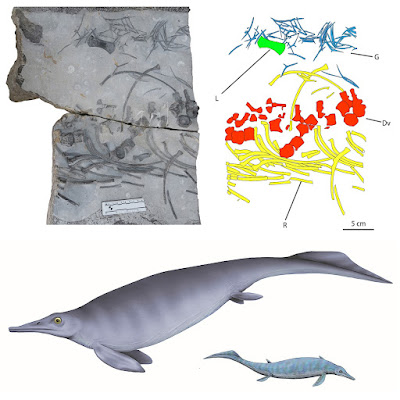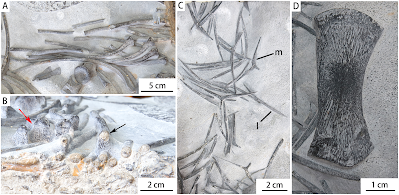[Most Recent Entries] [Calendar View]
Friday, April 15th, 2022
| Time | Event | ||||||
| 2:53a | [Botany • 2022] Yucca muscipula (Asparagaceae: Agavoideae) • A New Species from central Mexico
Abstract Yucca muscipula is described and illustrated as a new species endemic to the Barranca de Metztitlán Biosphere Reserve, Hidalgo, Mexico. This species is morphologically related to Y. mixtecana but is shorter, has a stem that lacks branching, and has glaucous leaves that are linear, with papillae on both surfaces and an entire margin, separating into recurved filaments. When dry, the leaves of Y. muscipula persist in the distal portion of the stem after the first flowering. It can grow sympatrically with Y. filifera, that also has a pendulous inflorescence and papillose filaments across entire surface, but from which it differs in several traits including glabrous branches, and larger flowers and fruits. Keywords: Agavaceae, Hidalgo, Sarcocarpa, Sierra Madre Oriental Yucca muscipula M. Ayala-Hern., Ríos-Gómez, E. Solano & A. García-Mend., sp. nov. Yucca muscipula is morphologically similar to Yucca mixtecana and to a few branched individuals of Y. filifera, from which it differs in the unbranched stem, and longer leaves that are persistent on the distal portion of the stem after the first flowering. Its tepals are 4–5 cm long, with the outer ones being 1.0–1.5 cm wide and the inner ones being 1.4–2.0 cm wide. Its filaments are 1.8–2.8 cm long and papillose, while its ovary is 1.8–2.3 cm long and 3.3–6.3 mm in diameter; the fruit and seeds seeds are larger than those of Y. filifera. Etymology:—The epithet is derived from the common name by which this plant is known in the type locality, “mousetrap palm” (mousetrap = muscipula). Uses:—The whole plant is used to establish living fences and the flowers are edible. María M. Ayala-Hernández, Ramiro Ríos-Gómez, Eloy Solano and Abisaí García-Mendoza. 2022. Yucca muscipula (Asparagaceae, Agavoideae), A New Species from central Mexico. Phytotaxa. 543(2); 103-112. DOI: 10.11646/phytotaxa.543.2.1 Resumen: Se describe e ilustra Yucca muscipula como especie nueva endémica de la Reserva de la Biosfera Barranca de Metztitlán, Hidalgo, México. Esta especie se relaciona morfológicamente con Y. mixtecana, pero difiere de esta por tener una menor altura, tallo sin ramificarse, hojas glaucas, lineares, con papilas en ambas superficies y margen entero separándose en filamentos recurvados. Cuando secas, las hojas persisten en la porción distal del tallo después de la primera floración. Y. muscipula puede crecer simpátricamente con Y. filifera, que también tiene una inflorescencia péndula y filamentos con papilas en toda su superficie, pero de la que difiere en varios rasgos, como ramas de la inflorescencia glabras, flores y frutos más grandes. | ||||||
| 2:54a | [Botany • 2022] Corybas kaiganganianus (Orchidaceae) • A New, Rare Helmet Orchid from Samar Island, Philippines
Corybas Salisbury (1807: t. 83) comprises approximately 120 highly distinctive and diminutive terrestrial and lithophytic species widely distributed from India to the western Pacific (Pridgeon et al. 2001, Aldrich & Haggins 2008, Chung & Hsu 2008, Chantanaorrapint & Chantanaorrapint 2016, Govaerts et al. 2019). The Philippines has six Corybas species (Pelser et al., 2011): C. boholensis Tandang, Bustamante, Reyes & Lyon (2020a: 261), Bohol, Visayas;, C. circinatus Tandang & Bustamante (2020b: 135), central Palawan; C. geminigibbus Smith (1927: 13), Mt. Victoria, Palawan; C. laceratus Williams (1937: 54), Rizal Prov., Luzon; C. merrillii (Ames) Ames (1908: 42), Mt. Mariveles, Luzon; and C. ramosianus Dransfield in Dransfield et al. (1986: 611), Ilocos Norte Prov., Luzon. Corybas is often overlooked and understudied owing to its diminutive size and ephemeral flowers (Tandang et al. 2020a), and ongoing explorations of the Philippine Archipelago have demonstrated the merit of this observation, with several species having been newly documented and described in recent years from areas that are known to have been botanized in the past. Keywords: Acianthinae, Diurideae, endemic, Malesia, taxonomy, Monocots Corybas kaiganganianus Marjorie D. Delos Angeles, Inocencio E. (Jr.) Buot, Cecilia B. Moran, Alastair S. Robinson and Danilo N. Tandang. 2022. Corybas kaiganganianus (Orchidaceae), A New, Rare Helmet Orchid from Samar Island, Philippines. Phytotaxa. 543(2); 127-134. DOI: 10.11646/phytotaxa.543.2.3 | ||||||
| 2:56a | [Botany • 2021] Begonia xenos (Begoniaceae) • A New Species and An Updated Checklist of Begonia in Laos
Abstract This study provides an updated list of Begonia occurring in Laos, and a new species is added to the checklist. The new taxon, Begonia xenos C.W.Lin, Phonep. & Rahm is similar to B. sinofloribunda Dorr in habit and leaf shape, but the new species differs in its staminate flowers having 4 tepals (vs. 2) with slightly crenulate (vs. entire) margins, pistillate flowers with 5 tepals (vs. 2 or 3) and a 2-locular (vs. 3-locular) ovary. Keywords: Eudicots, Begoniaceae, biodiversity, endemism, Indochina, limestone, Sect. Boisiana, Sect. Platycentrum, taxonomy Begonia xenos C.W.Lin, Phonep. & Rahm Che-Wei Lin, Phongphayboun Phonepaseuth and Peter Rahm. 2022. Begonia xenos—A New Species and An Updated Checklist of Begonia in Laos. Phytotaxa. 543(3); 193–202. DOI: 10.11646/phytotaxa.543.3.4 | ||||||
| 9:23a | [Botany • 2022] Hapaline kimthoae (Araceae: Caladieae) • A New Species from Da Nang Province, Vietnam
Abstract Hapaline kimthoae K.Z.Hein, Vuong & V.C.Nguyen from Da Nang province, Vietnam, is described and illustrated as a species new to science. Description, colour plates, discussion of similar taxa, phenology, distribution and a preliminary conservation status assessment are provided. With this discovery, Vietnam now holds a total of five Hapaline species. An identification key to these species is provided. Keyword: Aroideae, Caladieae, granite, Hapaline locii, H. kimthoae, plant taxonomy, South Central Coast
Hapaline kimthoae K.Z.Hein, Vuong & V.C.Nguyen, sp. nov. Diagnosis: This new species is morphologically similar to Hapaline locii V.D.Nguyen & Croat in having peduncle longer than petiole and spadix with sterile apex formed of fused synandrodes. But it differs significantly in having cuneate or obtuse leaf base (vs. rounded to cordate leaf base), pinkish white spathe with reddish brown tessellation (vs. dull light green or lime green spathe) and ovoid ovaries arranged in a single row (vs. bottle-shaped ovaries arranged in two alternating rows). Distribution and habitat: The new species can be found only from the type locality, Da Nang province of Vietnam. The species occurs along stream bank under lowland broadleaf evergreen forests in deep leaf litter soils over granites, at an altitude of about 700 m and associated with Aspdistra sp. Eponymy: The species named after Ms. Pham Thi Kim Thoa, Da Nang University of Science and Technology, who kindly supported the budget for the fieldworks. Van Canh Nguyen, Ba Vuong Truong, Van Vuong Le, Van Son Dang and Khant Zaw Hein. 2022. A New Species of Hapaline (Araceae: Caladieae) from Da Nang Province, Vietnam. Taiwania. 67(2); 239-242. DOI: 10.6165/tai.2022.67.239 | ||||||
| 10:43a | [Paleontology • 2022] Baisesaurus robustus • A New Basal Ichthyosauromorph from the Lower Triassic (Olenekian) of Zhebao, Guangxi Autonomous Region, South China
Abstract Here we describe a newly discovered basal ichthyosauromorph from the Lower Triassic of South China, Baisesaurus robustus gen. et sp. nov. The only known specimen of this new species was collected from the Lower Triassic (Olenekian) Luolou Formation in the Zhebao region of Baise City, on the northwest margin of the Nanpanjiang Basin, and comprises a partial skeleton including the ribs, the gastralia, a limb element, 12 centra, and seven neural arches. Comparisons to a wide variety of Early Triassic marine reptiles show Baisesaurus robustus to be a basal ichthyosauromorph based on the following features: neural arches lack transverse processes; dorsal ribs are slender, and not pachyostotic even proximally; and median gastral elements have long, sharp anterior processes. The limb element is long and robust, and is most likely to be a radius. Baisesaurus robustus is large (estimated length more than 3 m) relative to early ichthyosauromorphs previously discovered in China, and shares noteworthy morphological similarities with Utatsusaurus hataii, particularly with regard to body size and the morphology of the probable radius. Baisesaurus robustus also represents the first record of an Early Triassic ichthyosauromorph from Guangxi Autonomous Region, extending the known geographic distribution of ichthyosauromorphs in South China. Systematic Paleontology Reptilia Linnaeus, 1758 Diapsida Osborn, 1903 Ichthyosauromorpha Motani et al. 2015 Baisesaurus gen. nov. Etymology. “Baise” indicates the provenance of the only known specimen of the genus, which was discovered in Zhebao Township in Baise City; -saurus is a common suffix for genus names of fossil reptiles. Baisesaurus robustus sp. nov. Etymology. The Latin word robustus means “robust”. Holotype. CUGW VH107, a partial associated postcranial skeleton. Locality and horizon. Northwest margin of the Nanpanjiang Basin, Zhebao Township, Longlin County, Baise City, Guangxi, China; upper part of the Luolou Formation, Lower Triassic (upper Spathian). Diagnosis. A large basal ichthyosauromorph with a unique combination of postcranial characters (* denotes an autapomorphy): anterior dorsal centra deeply amphicoelous, with an average height to length ratio of about 1.2; neural spine long and inclined posteriorly, with the postzygapophyses much more dorsally positioned than the prezygapophyses; parapophyses subrectangular with their anteroventral corners extended to form ventrally directed apices, and situated adjacent to the anterior margins of the centra; diapophyses well developed and semicircular in outline; deep fossae present posterior to the diapophyses*; and radius robust, elongate, and bearing two distal facets, the posterior facet being 80% as wide as the anterior one*. Conclusions: Baisesaurus represents a newly reported large basal ichthyosauromorph from the Lower Triassic of South China. Among previously described taxa, Baisesaurus is most similar to Utatsusaurus, and differs from other, smaller Chinese early ichthyosauromorphs. Baisesaurus is the first Early Triassic ichthyosauromorph to be reported from Guangxi. Together with Cartorhynchus (Motani et al., 2015a), Sclerocormus (Jiang et al., 2016) and two recently discovered species of Chaohusaurus (Chen et al., 2013; Huang et al., 2019), Baisesaurus expands the known geographical distribution of early ichthyosauromorphs in China. Alongside other recent finds, Baisesaurus implies a need for further studies of the paleoecology and paleogeography of Early Triassic ichthyosauromorphs in order to understand their role in the ecosystem at the eastern margin of the Paleo-Tethys. The discovery of Baisesaurus has considerable paleogeographic significance, as well as adding to the documented taxonomic diversity of South China’s ichthyosaur fauna in the Spathian interval of the Early Triassic. Jicheng Ren, Haishui Jiang, Kunpeng Xiang, Corwin Sullivan, Yongzhong He, Long Cheng and Fenglu Han. 2022. A New Basal Ichthyosauromorph from the Lower Triassic (Olenekian) of Zhebao, Guangxi Autonomous Region, South China. PeerJ. 10:e13209. DOI: 10.7717/peerj.13209 | ||||||
| 3:23p | [Botany • 2022] Rediscovery of Gasteranthus extinctus L.E.Skog & L.P.Kvist (Gesneriaceae) at Multiple Sites in western Ecuador
Abstract We report the rediscovery of the Critically Endangered cloud forest herb Gasteranthus extinctus, not seen since 1985. In 2019 and 2021, G. extinctus was recorded at five sites in the western foothills of the Ecuadorian Andes, 4–25 km from the type locality at the celebrated Centinela ridge. We describe the species’ distribution, abundance, habitat and conservation status and offer recommendations for further research and conservation efforts focused on G. extinctus and the small, disjunct forest remnants it occupies. Keywords: Andes, Centinela, Chocó, cloud forest, endemic, extinction, iNaturalist, tropical forest Nigel C. A. Pitman, Dawson M. White, Juan Ernesto Guevara Andino, Thomas L. P. Couvreur, Riley P. Fortier, José Nicolás Zapata, Xavier Cornejo, John L. Clark, Kenneth J. Feeley, Mark K. Johnston, Alix Lozinguez and Gonzalo Rivas-Torres. 2022. Rediscovery of Gasteranthus extinctus L.E.Skog & L.P.Kvist (Gesneriaceae) at Multiple Sites in western Ecuador. PhytoKeys. 194: 33-46. DOI: 10.3897/phytokeys.194.79638 |
| << Previous Day |
2022/04/15 [Calendar] |
Next Day >> |

























